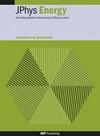Design of n-i-p and p-i-n Sb2Se3 solar cells: role of band alignment
IF 6.3
3区 材料科学
Q1 ENERGY & FUELS
引用次数: 0
Abstract
Investigations into novel device architectures and interfaces that enhance charge transport and collection are necessary to increase the power conversion efficiency (PCE) of antimony selenide (Sb2Se3) solar cells, which have shown great promise as a low-cost and high-efficiency alternative to conventional silicon-based solar cells. The current work uses device simulations to design p-i-n and n-i-p Sb2Se3-based solar cell structures. The n-i-p configuration is investigated by comparing distinct electron transport layer (ETL) materials to get the best performance. While certain ETL materials may yield higher efficiencies, the J–V curve may exhibit S-shaped behavior if there is a misalignment of the bands at the ETL/absorber interface. To address this issue, a proposed double ETL structure is introduced to achieve proper band alignment and conduction band offset for electron transport. A PCE of 20.15% was achieved utilizing (ZnO/ZnSe) as a double ETL and Spiro-OMeTAD as a hole transport layer (HTL). Further, the p-i-n configuration is designed by proposing a double HTL structure to facilitate hole transport and achieve a proper valence band offset. A double HTL consisting of (CuI/CuSCN) is used in conjunction with ETL-free configuration to achieve a PCE of 21.72%. The simulation study is conducted using the SCAPS-1D device simulator and is validated versus a previously fabricated cell based on the configuration FTO/CdS/Sb2Se3/Spiro-OMeTAD/Au.n-i-p和p-i-n Sb2Se3太阳能电池的设计:能带对准的作用
为了提高硒化锑(Sb2Se3)太阳能电池的功率转换效率(PCE),有必要研究增强电荷传输和收集的新型器件架构和接口,硒化锑(Sb2Se3)太阳能电池作为传统硅基太阳能电池的低成本和高效替代品显示出巨大的前景。目前的工作使用器件模拟来设计基于p-i-n和n-i-p sb2se3的太阳能电池结构。通过比较不同的电子传输层(ETL)材料,研究了n-i-p结构,以获得最佳性能。虽然某些ETL材料可能产生更高的效率,但如果在ETL/吸收器界面处存在能带错位,则J-V曲线可能呈现s形行为。为了解决这一问题,提出了一种双ETL结构,以实现适当的带对准和导带偏移。利用(ZnO/ZnSe)作为双ETL, Spiro-OMeTAD作为空穴传输层(html), PCE达到20.15%。此外,通过提出双HTL结构来设计p-i-n构型,以促进空穴传输并实现适当的价带偏移。由(CuI/CuSCN)组成的双html与无etl配置结合使用,可实现21.72%的PCE。模拟研究使用SCAPS-1D器件模拟器进行,并与先前基于FTO/CdS/Sb2Se3/Spiro-OMeTAD/Au配置制造的电池进行验证。
本文章由计算机程序翻译,如有差异,请以英文原文为准。
求助全文
约1分钟内获得全文
求助全文
来源期刊

Journal of Physics-Energy
Multiple-
CiteScore
10.90
自引率
1.40%
发文量
58
期刊介绍:
The Journal of Physics-Energy is an interdisciplinary and fully open-access publication dedicated to setting the agenda for the identification and dissemination of the most exciting and significant advancements in all realms of energy-related research. Committed to the principles of open science, JPhys Energy is designed to maximize the exchange of knowledge between both established and emerging communities, thereby fostering a collaborative and inclusive environment for the advancement of energy research.
 求助内容:
求助内容: 应助结果提醒方式:
应助结果提醒方式:


